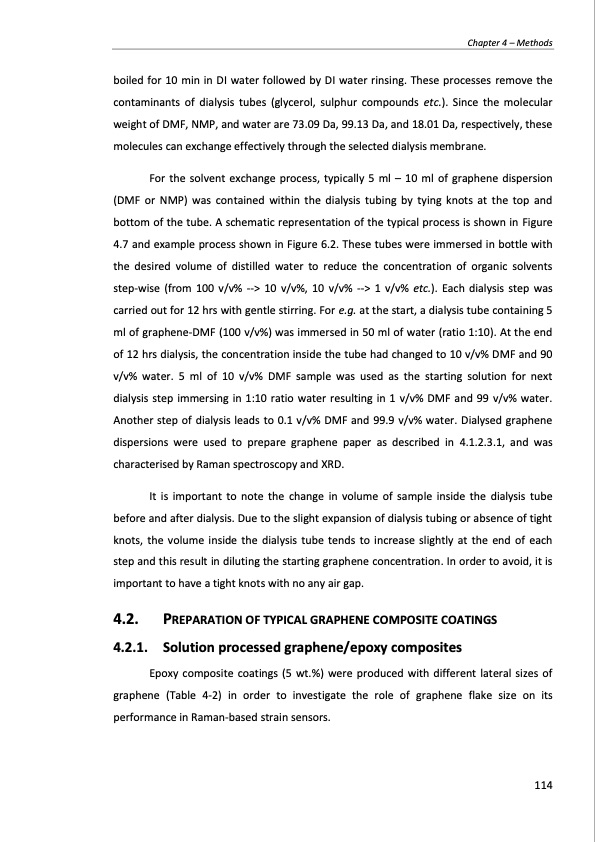
PDF Publication Title:
Text from PDF Page: 114
boiled for 10 min in DI water followed by DI water rinsing. These processes remove the contaminants of dialysis tubes (glycerol, sulphur compounds etc.). Since the molecular weight of DMF, NMP, and water are 73.09 Da, 99.13 Da, and 18.01 Da, respectively, these molecules can exchange effectively through the selected dialysis membrane. For the solvent exchange process, typically 5 ml – 10 ml of graphene dispersion (DMF or NMP) was contained within the dialysis tubing by tying knots at the top and bottom of the tube. A schematic representation of the typical process is shown in Figure 4.7 and example process shown in Figure 6.2. These tubes were immersed in bottle with the desired volume of distilled water to reduce the concentration of organic solvents step-wise (from 100 v/v% --> 10 v/v%, 10 v/v% --> 1 v/v% etc.). Each dialysis step was carried out for 12 hrs with gentle stirring. For e.g. at the start, a dialysis tube containing 5 ml of graphene-DMF (100 v/v%) was immersed in 50 ml of water (ratio 1:10). At the end of 12 hrs dialysis, the concentration inside the tube had changed to 10 v/v% DMF and 90 v/v% water. 5 ml of 10 v/v% DMF sample was used as the starting solution for next dialysis step immersing in 1:10 ratio water resulting in 1 v/v% DMF and 99 v/v% water. Another step of dialysis leads to 0.1 v/v% DMF and 99.9 v/v% water. Dialysed graphene dispersions were used to prepare graphene paper as described in 4.1.2.3.1, and was characterised by Raman spectroscopy and XRD. It is important to note the change in volume of sample inside the dialysis tube before and after dialysis. Due to the slight expansion of dialysis tubing or absence of tight knots, the volume inside the dialysis tube tends to increase slightly at the end of each step and this result in diluting the starting graphene concentration. In order to avoid, it is important to have a tight knots with no any air gap. 4.2. PREPARATION OF TYPICAL GRAPHENE COMPOSITE COATINGS 4.2.1. Solution processed graphene/epoxy composites Epoxy composite coatings (5 wt.%) were produced with different lateral sizes of graphene (Table 4-2) in order to investigate the role of graphene flake size on its performance in Raman-based strain sensors. Chapter 4 – Methods 114PDF Image | PRODUCTION AND APPLICATIONS OF GRAPHENE AND ITS COMPOSITES

PDF Search Title:
PRODUCTION AND APPLICATIONS OF GRAPHENE AND ITS COMPOSITESOriginal File Name Searched:
graphene-production-applications.PDFDIY PDF Search: Google It | Yahoo | Bing
Salgenx Redox Flow Battery Technology: Power up your energy storage game with Salgenx Salt Water Battery. With its advanced technology, the flow battery provides reliable, scalable, and sustainable energy storage for utility-scale projects. Upgrade to a Salgenx flow battery today and take control of your energy future.
| CONTACT TEL: 608-238-6001 Email: greg@infinityturbine.com | RSS | AMP |